
Most tornadoes take on the appearance of a narrow funnel, a few hundred yards (meters) across, with a small cloud of debris near the ground. Tornadoes may be obscured completely by rain or dust. These tornadoes are especially dangerous, as even experienced meteorologists might not see them. Tornadoes can appear in many shapes and sizes.
Small, relatively weak landspouts may be visible only as a small swirl of dust on the ground. Although the condensation funnel may not extend all the way to the ground, if associated surface winds are greater than 40 mph (64 km/h), the circulation is considered a tornado. A tornado with a nearly cylindrical profile and relative low height is sometimes referred to as a "stovepipe" tornado. Large single-vortex tornadoes can look like large wedges stuck into the ground, and so are known as "wedge tornadoes" or "wedges". The "stovepipe" classification is also used for this type of tornado, if it otherwise fits that profile. A wedge can be so wide that it appears to be a block of dark clouds, wider than the distance from the cloud base to the ground. Even experienced storm observers may not be able to tell the difference between a low-hanging cloud and a wedge tornado from a distance. Many, but not all major tornadoes are wedges.

Tornadoes in the dissipating stage can resemble narrow tubes or ropes, and often curl or twist into complex shapes. These tornadoes are said to be "roping out", or becoming a "rope tornado". When they rope out, the length of their funnel increases, which forces the winds within the funnel to weaken due to conservation of angular momentum. Multiple-vortex tornadoes can appear as a family of swirls circling a common center, or may be completely obscured by condensation, dust, and debris, appearing to be a single funnel.
In the United States, tornadoes are around 500 feet (150 m) across on average and stay on the ground for 5 miles (8.0 km). Yet, there is a wide range of tornado sizes. Weak tornadoes, or strong yet dissipating tornadoes, can be exceedingly narrow, sometimes only a few feet or couple meters across. One tornado was reported to have a damage path only 7 feet (2 m) long. On the other end of the spectrum, wedge tornadoes can have a damage path a mile (1.6 km) wide or more. A tornado that affected Hallam, Nebraska on May 22, 2004, was up to 2.5 miles (4.0 km) wide at the ground.
In terms of path length, the Tri-State Tornado, which affected parts of Missouri, Illinois, and Indiana on March 18, 1925, was on the ground continuously for 219 miles (352 km). Many tornadoes which appear to have path lengths of 100 miles (160 km) or longer are composed of a family of tornadoes which have formed in quick succession; however, there is no substantial evidence that this occurred in the case of the Tri-State Tornado. Modern reanalysis of the path suggests that the tornado may have begun 15 miles (24 km) further west than previously thought, lengthening its track.
Appearance
Tornadoes can have a wide range of colors, depending on the environment in which they form. Those which form in a dry environment can be nearly invisible, marked only by swirling debris at the base of the funnel. Condensation funnels which pick up little or no debris can be gray to white. While traveling over a body of water as a waterspout, they can turn very white or even blue. Funnels which move slowly, ingesting a lot of debris and dirt, are usually darker, taking on the color of debris. Tornadoes in the Great Plains can turn red because of the reddish tint of the soil, and tornadoes in mountainous areas can travel over snow-covered ground, turning white.

Lighting conditions are a major factor in the appearance of a tornado. A tornado which is "back-lit" (viewed with the sun behind it) appears very dark. The same tornado, viewed with the sun at the observer's back, may appear gray or brilliant white. Tornadoes which occur near the time of sunset can be many different colors, appearing in hues of yellow, orange, and pink.
Dust kicked up by the winds of the parent thunderstorm, heavy rain and hail, and the darkness of night are all factors which can reduce the visibility of tornadoes. Tornadoes occurring in these conditions are especially dangerous, since only weather radar observations, or possibly the sound of an approaching tornado, serve as any warning to those in the storm's path. Most significant tornadoes form under the storm's updraft base, which is rain-free, making them visible. Also, most tornadoes occur in the late afternoon, when the bright sun can penetrate even the thickest clouds. Night-time tornadoes are often illuminated by frequent lightning.
There is mounting evidence, including Doppler On Wheels mobile radar images and eyewitness accounts, that most tornadoes have a clear, calm center with extremely low pressure, akin to the eye of tropical cyclones. This area would be clear (possibly full of dust), have relatively light winds, and be very dark, since the light would be blocked by swirling debris on the outside of the tornado. Lightning is said to be the source of illumination for those who claim to have seen the interior of a tornado.
Rotation
Tornadoes normally rotate cyclonically in direction (counterclockwise in the northern hemisphere, clockwise in the southern). While large-scale storms always rotate cyclonically due to the Coriolis effect, thunderstorms and tornadoes are so small that the direct influence of the Coriolis effect is unimportant, as indicated by their large Rossby numbers. Supercells and tornadoes rotate cyclonically in numerical simulations even when the Coriolis effect is neglected. Low-level mesocyclones and tornadoes owe their rotation to complex processes within the supercell and ambient environment.
Approximately 1 percent of tornadoes rotate in an anticyclonic direction in the northern hemisphere. Typically, systems as weak as landspouts and gustnadoes can rotate anticyclonically, and usually only those which form on the anticyclonic shear side of the descending rear flank downdraft in a cyclonic supercell. On rare occasions, anticyclonic tornadoes form in association with the mesoanticyclone of an anticyclonic supercell, in the same manner as the typical cyclonic tornado, or as a companion tornado either as a satellite tornado or associated with anticyclonic eddies within a supercell.
Sound and seismology
Tornadoes emit widely on the acoustics spectrum and the sounds are caused by multiple mechanisms. Various sounds of tornadoes have been reported throughout time, mostly related to familiar sounds for the witness and generally some variation of a whooshing roar. Popularly reported sounds include a freight train, rushing rapids or waterfall, a nearby jet engine, or combinations of these. Many tornadoes are not audible from much distance; the nature and propagation distance of the audible sound depends on atmospheric conditions and topography.
The winds of the tornado vortex and of constituent turbulent eddies, as well as airflow interaction with the surface and debris, contribute to the sounds. Funnel clouds also produce sounds. Funnel clouds and small tornadoes are reported as whistling, whining, humming, or the buzzing of innumerable bees or electricity, or more or less harmonic, whereas many tornadoes are reported as a continuous, deep rumbling, or an irregular sound of "noise".
Since many tornadoes are audible only when very near, sound is not reliable warning of a tornado. And, any strong, damaging wind, even a severe hail volley or continuous thunder in a thunderstorm may produce a roaring sound.

Tornadoes also produce identifiable inaudible infrasonic signatures.
Unlike audible signatures, tornadic signatures have been isolated; due to the long distance propagation of low-frequency sound, efforts are ongoing to develop tornado prediction and detection devices with additional value in understanding tornado morphology, dynamics, and creation. Tornadoes also produce a detectable seismic signature, and research continues on isolating it and understanding the process.
Electromagnetic, lightning, and other effects
Tornadoes emit on the electromagnetic spectrum, with sferics and E-field effects detected. There are observed correlations between tornadoes and patterns of lightning. Tornadic storms do not contain more lightning than other storms and some tornadic cells never produce lightning. More often than not, overall cloud-to-ground (CG) lightning activity decreases as a tornado reaches the surface and returns to the baseline level when the tornado lifts. In many cases, intense tornadoes and thunderstorms exhibit an increased and anomalous dominance of positive polarity CG discharges. Electromagnetics and lightning have little or nothing to do directly with what drives tornadoes (tornadoes are basically a thermodynamic phenomenon), although there are likely connections with the storm and environment affecting both phenomena.
Luminosity has been reported in the past and is probably due to misidentification of external light sources such as lightning, city lights, and power flashes from broken lines, as internal sources are now uncommonly reported and are not known to ever have been recorded. In addition to winds, tornadoes also exhibit changes in atmospheric variables such as temperature, moisture, and pressure. For example, on June 24, 2003 near Manchester, South Dakota, a probe measured a 100 mbar (hPa) (2.95 inHg) pressure decrease. The pressure dropped gradually as the vortex approached then dropped extremely rapidly to 850 mbar (hPa) (25.10 inHg) in the core of the violent tornado before rising rapidly as the vortex moved away, resulting in a V-shape pressure trace. Temperature tends to decrease and moisture content to increase in the immediate vicinity of a tornado.
No comments:
Post a Comment